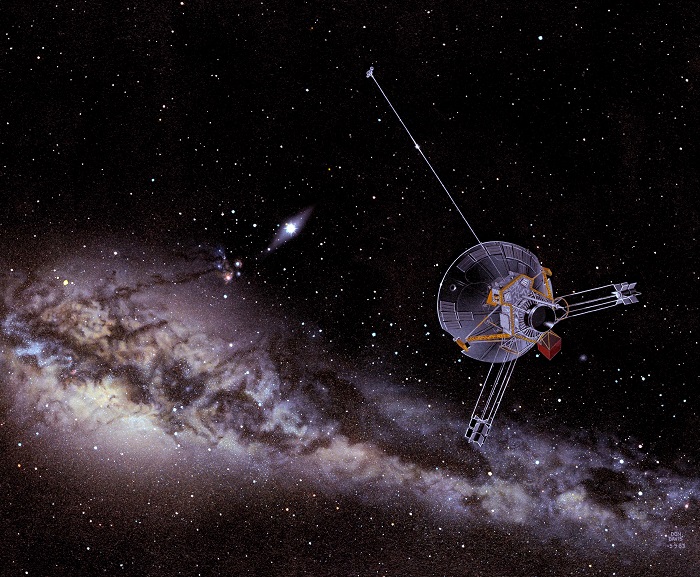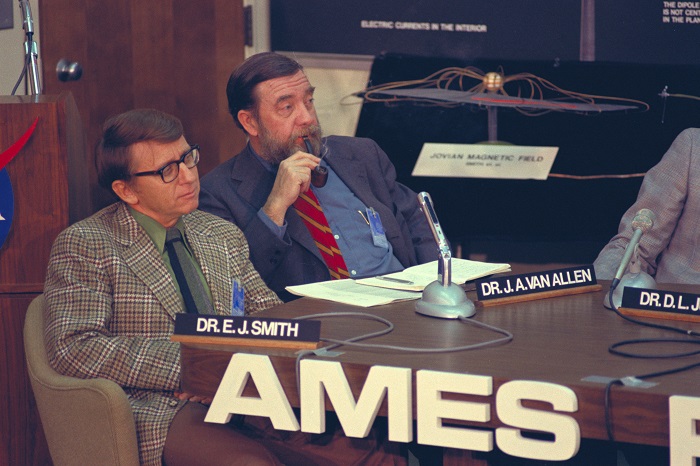.

NASA Celebrates Four Decades of Plucky Pioneer 11
.
Forty years ago, on April 5, 1973, a small, ambitious spacecraft launched from Cape Canaveral, heading towards the third-brightest point of light in the night sky. Following in the footsteps of its sister craft, Pioneer 10, Pioneer 11 was intended as a backup for the dangerous mission. A single additional instrument, a Flux-Gate Magnetometer, was the only difference between Pioneer 11 and the craft that had already become the first human-made object to leave the inner solar system and was well on its journey to the first and most massive of the gas giant planets, Jupiter.
By the beginning of 1974, Pioneer 10’s journey to Jupiter had proved to be an unmitigated success - the craft had sustained no damage through the asteroid belt, little lasting radiation damage during it’s encounter with Jupiter and had returned far greater volumes of scientific data than expected. After Pioneer 10 successfully survived the Jovian encounter, Pioneer 11 was retargeted mid-flight to include another planetary encounter. The science team at NASA's Ames Research Center in California decided not simply to duplicate Pioneer 10’s mission, but to build upon it, directing the small craft to use Jupiter’s massive gravitational pull as a slingshot to propel the craft at a significantly increased velocity (just as had been done to propel Pioneer 10 out the solar system) to the next – and arguably most beautiful – planet in our system, Saturn.
After some pressure from the Voyager team at NASA’s Jet Propulsion Laboratory in Pasadena, Calif., who wanted Pioneer to test the path that Voyager would follow several years later, a decision was made to travel much closer to Jupiter than Pioneer 10. This more risky path was opposed by some of the Pioneer team, but on December 2, 1974, Pioneer 11 passed only 42,000 km (compared to Pioneer 10’s 200,000 km) above Jupiter’s cloud tops. Pioneer 11’s route took the spacecraft over the poles of the planet to avoid the intense radiation belts around Jupiter’s equator. This allowed the first mapping of the planet’s polar regions and sent the craft hurtling through space at a record speed of 172,800 km/h. During its encounter, Pioneer 11 managed to take the most detailed images of the Great Red Spot and calculated the mass of the moon Calisto.
Because of Pioneer 11’s ambiguous status as a combination science and engineering demonstration mission, a heated debate broke out in the NASA community about what route it would take past Saturn. The famous Voyager missions were launched a full two years before Pioneer 11 reached Saturn and were already heading towards Jupiter through what was now known to be virtually risk-free asteroid belt. The Voyager spacecraft were much more sophisticated and cost many times more than the relatively simple Pioneer probes. Voyager 2’s “Grand Tour” of the Solar System (which involved visiting Jupiter, Saturn, Uranus and Neptune) required that the spacecraft travel through Saturn’s outer A ring in order to get close enough to use gravitational assist to propel it to Uranus.
Scientists at the time were unsure of the makeup of the rings and were worried, as they were for Pioneer 10’s journey through the asteroid belt, that the spacecraft might be impacted and destroyed by objects in the ring. The material in the rings (now known to be mainly comprised of water ice) needed, on average, to be smaller than 1 mm, in which case they would be unlikely to damage the spacecraft, or larger than 1 cm so that they would be spaced far enough apart to allow a spacecraft to pass through them. If they fell between these two sizes, then a lethal impact was nearly inevitable. Having already got more than they bargained for, the Pioneer team was ready to go out with a bang. They opted to risk their trusty spacecraft by sending it on a much more dangerous route through Saturn’s mysterious inner rings. This would maximize the scientific effectiveness of the mission and would prove the existence of the suspected D ring between the readily visible C ring and the planet’s upper atmosphere. The team was willing to take the more treacherous, unknown path for the sake of science. The Voyager team, however, had always seen Pioneer as a prelude to their more advanced mission and were adamant that the craft should test the route that Voyager 2 would take through the outer E ring two years later en route to Uranus.
There were convincing arguments on both sides: the Pioneer team argued that the outer path would be too far away from Saturn for either spacecraft to take the measurements the scientists were interested in, while the Voyager team insisted that they could not risk passing through the rings without Pioneer testing them first.
Ultimately, it was decided by NASA Headquarters that Voyager 2’s safe passage to Uranus and Neptune would yield more scientific discovery than Pioneer’s path through the inner rings of Saturn and, to the sound of much booing from the Pioneer team, NASA director of Planetary Programs Tom Young announced Pioneer 11’s trajectory would be to the planet’s outer rings.
Certainly the decision to change Pioneer from a trailblazer into guinea pig, as some saw it, upset a number of the mission’s strongest supporters - especially the scientists who were hoping for another chance to use their instruments fully - but as time has passed, many people have changed their opinion of the contentious verdict.
“It was a controversial decision at the time,” mused Pioneer’s last project manager, Larry Lasher. “But with the brave path it forged, Pioneer 11 was proud to contribute to the success of Voyager 2 in its completion of the “Grand Tour,” and the exploration of two of the outermost planets in our Solar System.”
Despite its altered trajectory, which took it within 21,000 km of the Saturn, Pioneer 11 discovered two new moons (almost smacking into one of them in September 1979) and a new “F” ring. The spacecraft also discovered and charted the planet's magnetic field and magnetosphere, and mapped the general structure of Saturn's interior. The spacecraft's instruments measured the heat radiation from Saturn's interior and found that its planet-sized moon, Titan, was too cold to support life.
Pioneer 11’s mission was only planned to last 21 months – just long enough to reach Jupiter – but in reality, the spacecraft continued functioning for decades after the end of its nominal mission. Pioneer 11’s most important milestone - the first encounter with Saturn - occurred eight months after its projected lifespan, while it became the fourth (Voyagers 1 and 2 had, by this time, overtaken it) human-made object to leave the planetary solar system almost 17 years after its launch on Feb 23, 1990. Thanks to the leadership of its legendary first project manager, Charles Hall, Pioneer could be seen as the prototype for cheaper, better, faster missions that followed in the 1990s.
Pioneer 11, ended its mission on Sept. 30, 1995, when the last transmission from the spacecraft was received. At that time, it took a full 12 hours for a radio signal (traveling at the speed of light) to reach the spacecraft. Currently, it is approximately 13 billion km from the sun and traveling in the direction of the constellation Scutum.
.

Legendary space scientist James van Allen is seen smoking a pipe alongside physicist Edward Smith at a Pioneer 11 press conference in 1974. Image credit: NASA Ames
.
Quelle: NASA
